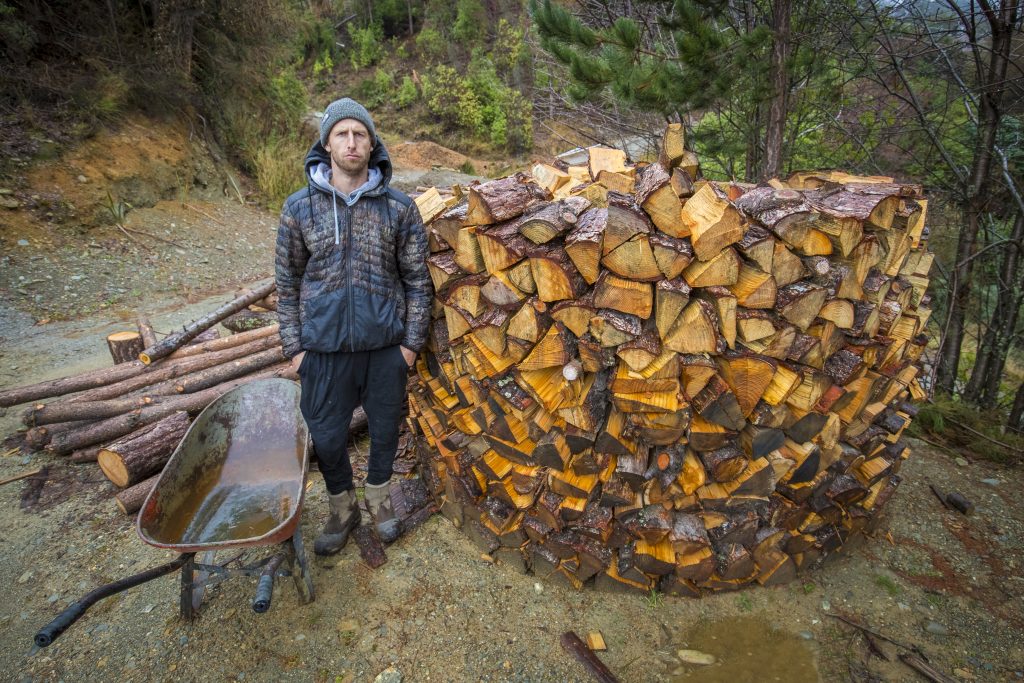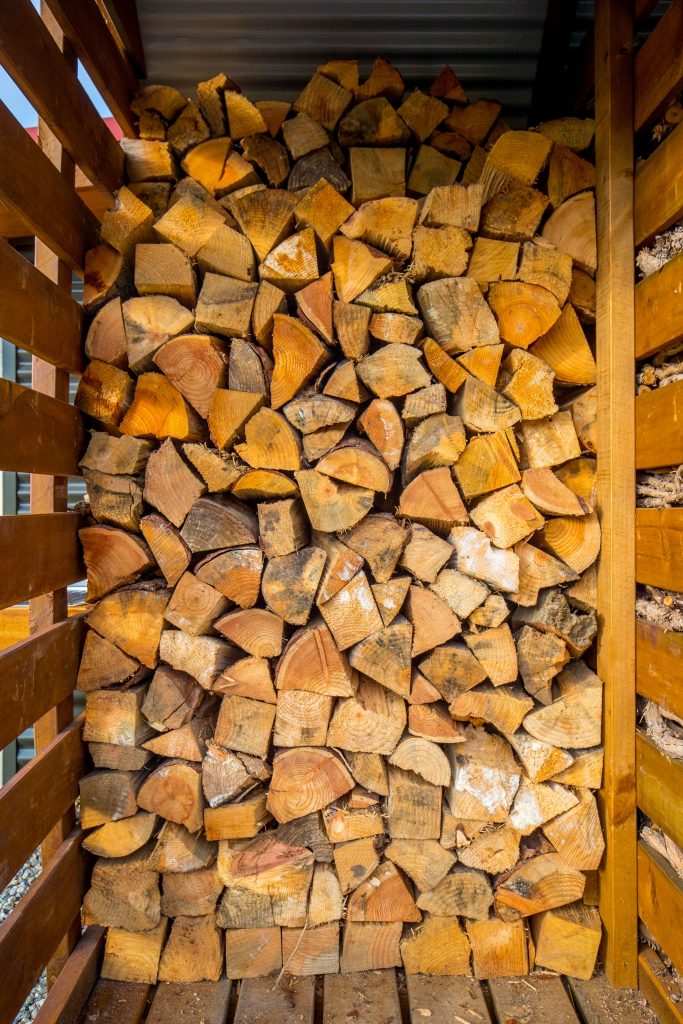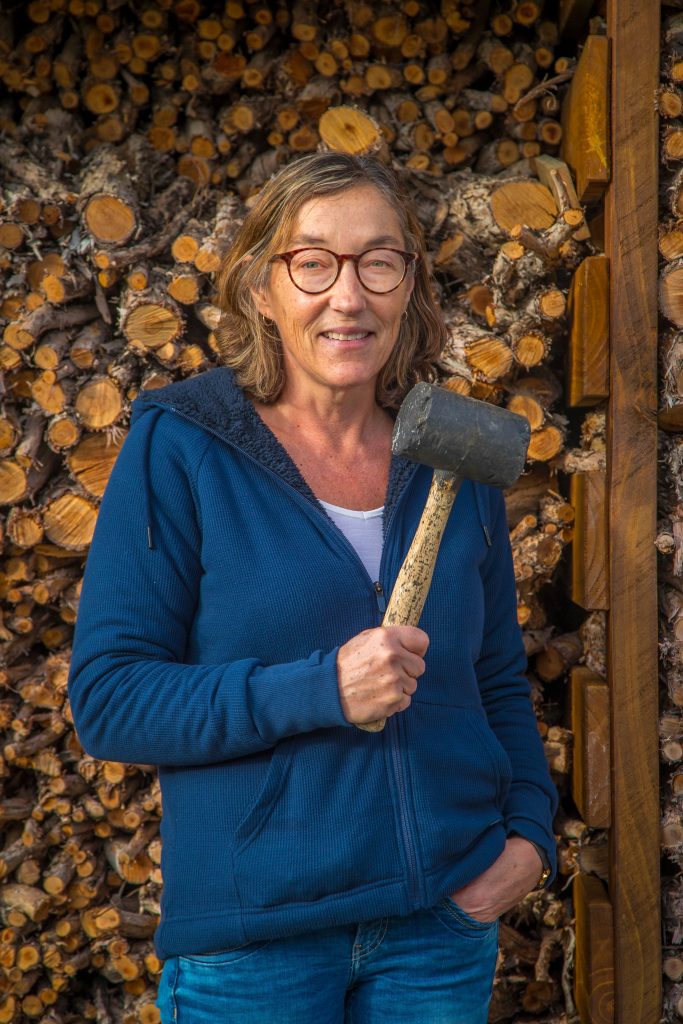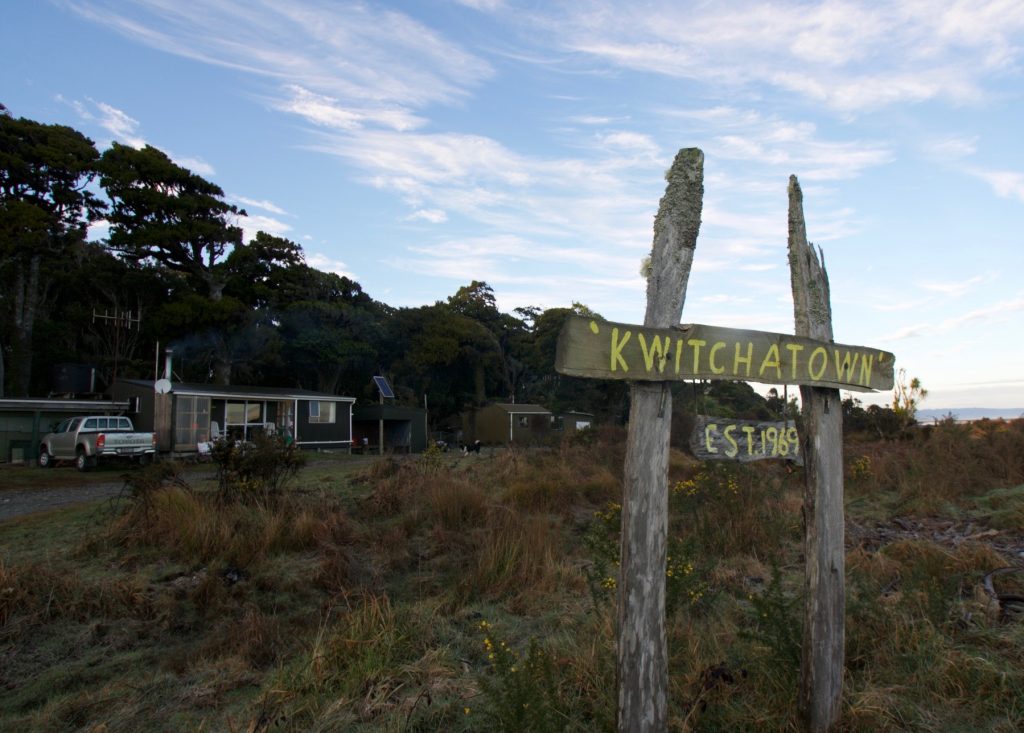According to William Shakespeare, the fire that’s closest kept burns most of all. Allan Uren investigates.
FORAGING FOR FIREWOOD IS HARD WORK. AS THE SAYING GOES, IT WARMS YOU TWICE. OR, AS WĀNAKA FIREWOOD ENTHUSIAST TOM O’DONNELL LIKES TO SAY, IT ACTUALLY WARMS YOU FIVE TIMES: CUTTING DOWN THE TREE, RINGING IT, SPLITTING IT, STACKING IT, THEN BURNING IT. A FEW YEARS AGO, TOM DISCOVERED A BOOK CALLED NORWEGIAN WOOD: CHOPPING, STACKING, AND DRYING WOOD THE SCANDINAVIAN WAY BY LARS MYTTING. “I SHED A TEAR WHEN I FOUND THAT BOOK. IT MEANT I WASN’T ALONE. THERE WAS SOMEONE OUT THERE WHO UNDERSTOOD WHY I GET SO EXCITED ABOUT FIREWOOD.”
It’s true. When Tom talks about wood, he becomes more and more animated, speaks louder and louder, and closes his eyes.
It’s an autumn day, and we head out to the Maungawera Valley in Tom’s truck, which is loaded up with a quiver of chainsaws. We take a tour of Kirsty and Colin Sutherland’s farm, and he shows me a gnarly old pine tree that has grown in isolation. These trees are crippled things bristling with limbs like lances, and approaching them with a view to cutting them down evinces a feeling of “where do I start.” Felling one is a serious business.
As Tom tells it, “years ago I was dropping a multi-limbed macrocarpa. It was all twisted out of shape, but I thought I’d worked out how it would fall. There was a swirling breeze. I was making the final cut. There’s no bullshit now.” He pauses. “And rather than it falling where I thought, it jumped straight back onto the stump and nearly marmited me.” Despite not being a religious man, he adds, almost quietly, “I say a little prayer when I drop one of those now.”

Even in New Zealand, where we don’t get the screaming cold of other countries, we still have to heat our homes, and for many of us heat pumps just don’t cut it. Burning firewood is still one of the most popular forms of warming our houses. In Wānaka, local merchants Upper Cut Firewood sell 20,000 cubic metres of wood pre-winter. Christchurch’s City Firewood sell a massive 50,000 cubic metres. And, according to last year’s census, about 575,000, or 40%, of New Zealand households still use wood for home heating.
Why is burning wood so popular? Other forms of heating are less messy, and you can even turn some on remotely with your cell phone. One reason folk are quick to roll out is, “you can’t beat the heat a fire gives off.” It’s not a very scientific answer, but it’s true. It’s a vibe. Staring at a fire on a winter night, watching the changing patterns, brings on a sense of peace, of wellbeing. There’s life in the flames. Staring at a plastic cowling doesn’t have the same effect.
During the Otago Gold Rush of 1861 to 1864, firewood was scarce. If you were Marty McFly and able to travel back to 1400CE in your DMC DeLorean time machine, you would find the mountains surrounding Wānaka, and most of Central Otago, covered with totora up to 1200 metres above sea level; red beech charcoal has been discovered at 1,127 metres on the Crown Range. Around 600 years ago, there was a change in the pollen record in inland Otago from forest to bracken flora, possibly due to fires lit by people exploring the area.
“YOU CAN TELL A LOT ABOUT A PERSON’S CHARACTER BY STUDYING THEIR WOOD STACK.”
According to Steven Eldred-Grigg’s book Diggers, Hatters and Whores: The story of the New Zealand Gold Rushes, a working day in the goldfields only came to an end when the diggers could no longer see to dig. Fires were then needed for boiling water and cooking food, but firewood was hard to come by, so they burned tussocks or trekked far from the camps in search of woody shrubs. Describing the conditions at Gabriels Gully in the 1860s, Lawrence-based barrister and Freemason John Mouat wrote there was, “no fuel for warmth, only for cooking.” When things got grim in the Otago diggings, some unfortunates would even sneak out to dig up wooden sheep fence posts for burning.
In a paddock, we approach a tree Tom felled a few months ago. He’s here to chew it down into useable pieces to be split. Tom grew up on a farm near Mount Taranaki, but he didn’t use a chainsaw until going to Canada as a young man planting pine trees, which, watching him now, is hard to believe. The late autumn sun is low on the horizon, and Tom casts a long wide shadow as he approaches the tree. With his saw running he leans into it, and the saw bites and roars as woodchips stream out the back. He has to hold the heavy saw up high and I can see the sweat starting to form on his face.
Using a chainsaw can be a pleasurable activity and Jean Kenney, an owner-operator at Tree Tamers, an arborist company in Wānaka, has a theory as to why. The Chinese, she says, believe all the natural elements are connected. “Wood feeds fire,” she explains, “fire makes earth. Earth creates metal. Fire melts metal and metal cuts wood. Each element both controls and is controlled by another element. The system is connected, moving and constantly in a process of balance.”

I don’t think Tom considers this as he finishes burning through a tank of fuel, chunks of wood jumbled around him. The trouble, or maybe advantage, of having a hobby that produces a sought-after commodity is: what do you do with it all? According to Tom, “oh, I give a lot away. Mostly to little old ladies and ex-flatmates.” Pressed further, he reveals that he chops up about 10 to 12 cubic metres of firewood a year, which equates to around $1200. If he were to sell it.
Most serious amateur fire-wooders use a mechanical wood splitter, which isn’t as romantic as an axe. But if you’ve got wood with large knots, using a splitting axe will eventually break you, no matter how strong you are. Milo Gilmour, arborist, rock climber, mountaineer and co-owner of Tree Tamers, enjoys wielding an axe. “I like the feeling of focus, of aiming at the sweet spot in the log and it flying apart. You get your eye in and read the wood, finding the weaknesses almost by instinct. When you’ve got good wood and a sharp log-splitting axe, it’s almost effortless. And there’s a satisfying crack as it flies apart. There are often natural splits in the ring – you aim for one of those.”
Sometimes, despite all the zen concentration, the axe will bury itself in a ring, and it’s like a malevolent sponge with super clamping powers has grabbed onto the metal. If it isn’t too stuck, you can lift the ring up holus bolus and knock it on its edge enough to loosen the axe.
Splitting green (as in “the birds are still whistling in it” green) freshly-ringed wood can be easy, while rings that have dried out, for example in eucalyptus, can turn to iron, and your axe will just bounce off it. It’s like trying to split an anvil. Sometimes with stubborn wood you can chip away at the edges until the ring becomes small enough that a good smack in the middle will be the winning blow. Whatever happens, the physical and mental focus is sure good for your mental health. As my grandmother used to say, you can’t stay angry when you’re splitting wood.
There’s an old Norwegian proverb (or maybe I just made it up): “if you look after your firewood, your firewood will look after you.” Stacking is important. It not only gets the stuff off your driveway, it protects it from getting wet, so it burns well. Tip: Stacking your wood on pallets to keep it off the ground allows air movement to optimise drying. But can it be too dry?
According to Ivan Murdoch from Uppercut Firewood, you should burn firewood that is below 20 per cent moisture content. This methodology isn’t scientific, but to check, knock two pieces of wood together. You should get a pleasant high-pitched “dong dong”, not unlike the sound from a clave, the percussion instrument made from short wooden dowels. Another way to test is to burn a few pieces. If there’s hissing and bubbling coming from the ends, you’re doing more harm than good. Wet wood clogs up your chimney with creosote and the resulting smoke creates unacceptable levels of pollution.
Some people just hurl their wood into the shed; for others, stacking is a ritualistic endeavour where each piece jigsaws to the last piece in an orderly pattern. It doesn’t matter that the pattern only lasts a few months, it’s the order that’s important. Jo Stroud is such a person. She can’t stand to have an untidy wood stack. Much like a stonemason building a schist rock wall, she’ll hunt for the right piece of wood to fit nicely against the last one. But a warning: all that neatness can be detrimental to drying. You have to be careful not to stack the wood too tight, always leaving enough space between the logs for a mouse to run through.

You can tell a lot about a person’s character by studying their wood stack. Here are a few rules of thumb:
Upright and solid pile: Upright and solid person. Low pile: Cautious, could be shy or weak.
A lot of wood: Someone of foresight, loyal. But may be a hoarder.
Collapsed pile: Weak will, poor judge of priorities.
Pedantic tidy pile: This person is generally conscientious – they pay attention to order, think before they act, but may be a perfectionist. (Which is fine so long as you’re a “normal perfectionist”, not a neurotic one. D. E. Hamachek said in 1978 that a normal perfectionist is more inclined to pursue perfection without it affecting their self-esteem and thereby derives pleasure from their efforts. So there.)
If you passed your camp-fire lighting exam when you were a Girl Guide or Boy Scout, then lighting a fire at home is probably as easy as falling off a log. You follow the simple rules. Start with crumpled newspaper, small amounts of kindling (cedar is the best), then add larger pieces as the flames take hold. Break the rules and you may end up in that frustration-space usually reserved for computer malfunctions. Remember, lighting a fire requires your full attention. Chuck a few random pieces of damp wood on some balled-up newspaper and you’ll come back in a few minutes to witness the Lilliputian firefighters with their wee fire hoses pouring water on any hope you had of warmth.
Understanding the combustion process helps. There are three phases. When a log is first put on a fire, the moisture inside it begins to evaporate. This takes energy from the rest of the fire, and is the reason unseasoned wood steals your heat. Once the outer parts of the log are dry enough, the temperature rises, the wood releases gas, and flames appear. It may seem at this second stage that the wood itself has caught fire, but something surprising is actually happening. The flames we see aren’t from the wood itself, but from the burning gases that jet from within it once a certain temperature is reached. Simply put, the wood is cooked until it is dry. Gases start to percolate and ignite. Then, once the gases are exhausted, the third and final stage begins. The wood has become charcoal and is glowing at more than 1100 degrees Celsius. Now all three processes go on at the same time, each feeding the other.

My father-in-law has just come back from visiting his bach at Kwitchatown, a settlement of fishing dwellings on the north bank of the Haast River (and where each bach has a local name, like Kwitchanaggin or Kwitchajob). He’s whitebaited there for 30 years, and he loves it. To the uninitiated, whitebaiting might appear boring, sitting by the river for hours, not doing anything but watching. But in these moments he’s calm and content and doesn’t seem to want for anything as the surf pounds the beach and an easterly breeze pushes dust down the Haast Valley.
He was a government deer culler in the early 1960s, and lived in forest service huts for weeks on end. There was a rule for those huts: you never left without replenishing the wood supply, so the next bloke who turned up wet and hungry could start a fire.
The last few seasons on the Coast have been a battle with the elements. It may be climate change, or maybe the river has just decided to take a holiday through Kwitchatown, but it’s been chomping away at the sandy bank. Already, a house bus and tractor have fallen into the water and the bank where he fishes, which used to be 100 metres further out in the river, has become a two- metre high obstacle. There’s no way of building his whitebait stand and anyway, he’s on the other side of 80.
But this June, my father-in-law spent four days splitting and stacking wood for the coal range that supplies all the heating and hot water for the bach. Now, if his aching body allows, and the spring storms aren’t too horrendous, and the river doesn’t flood too often, he’ll be back, content in the knowledge that, whatever else happens, he has enough firewood.
ALLAN UREN

